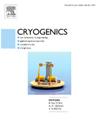开发模拟低温罐主动加压的数值方法
IF 1.8
3区 工程技术
Q3 PHYSICS, APPLIED
引用次数: 0
摘要
在这项研究中,提出了一种适用于描述低温罐内主动加压的主要热流体力学现象的数值方法。这项任务是将几个模型的数值预测结果与从文献中检索到的液氮(N2)罐加压高温气态 N2 的地面主动加压实验结果进行比较。氮气罐被模拟为二维轴对称模型,通过共轭传热模型将通过氮气罐壁的热传导解法与流体动力学解法耦合在一起。两相流体界面采用流体体积(VOF)法进行跟踪,相变采用 Lee 模型进行计算。由于工作温度范围较宽,因此考虑了蒸汽和壁面的温度变化热物理性质。所提出的方法可以准确地再现气体注入过程中的压力上升率和气体注入结束后的压力下降。最后,研究结果表明,有必要引入湍流模型,以更高的保真度描述主动加压阶段,而且在测试的模型中,具有低雷诺修正的 SST k-ω 模型最适合表示气体注入结束后出现的压力下降。本文章由计算机程序翻译,如有差异,请以英文原文为准。
Development of a numerical methodology for the simulation of active-pressurization of cryogenic tanks
In this study, a numerical methodology, which is suitable to describe the main thermo-fluid-dynamics phenomena characterizing the active-pressurization inside cryogenic tanks, is proposed. This task is carried out comparing the numerical predictions obtained with several models with experimental results, retrieved from the literature, of a ground-based active-pressurization experiment of a liquid nitrogen (N2) tank pressurized with high temperature gaseous N2. The tank is modeled as 2D axisymmetric, and the solution of the heat conduction through the tank wall is coupled to the fluid-dynamic solution by means of a conjugate heat transfer model. The two-phase fluid interface is tracked using the Volume-of-Fluid (VOF) method, and the phase transition is calculated with the Lee model. Temperature varying thermophysical properties are considered for the vapor and the wall, given the wide operational temperature range. The proposed methodology allows to accurately reproduce both the pressure rise rate during gas injection and the pressure drop occurring after the end of gas injection. Finally, the results show that the introduction of a turbulence model is necessary to describe, with higher fidelity, the active-pressurization phase and that, among the tested models, the SST with low-Reynolds corrections is the most adequate to represent the pressure decrease occurring after the end of gas injection.
求助全文
通过发布文献求助,成功后即可免费获取论文全文。
去求助
来源期刊

Cryogenics
物理-热力学
CiteScore
3.80
自引率
9.50%
发文量
0
审稿时长
2.1 months
期刊介绍:
Cryogenics is the world''s leading journal focusing on all aspects of cryoengineering and cryogenics. Papers published in Cryogenics cover a wide variety of subjects in low temperature engineering and research. Among the areas covered are:
- Applications of superconductivity: magnets, electronics, devices
- Superconductors and their properties
- Properties of materials: metals, alloys, composites, polymers, insulations
- New applications of cryogenic technology to processes, devices, machinery
- Refrigeration and liquefaction technology
- Thermodynamics
- Fluid properties and fluid mechanics
- Heat transfer
- Thermometry and measurement science
- Cryogenics in medicine
- Cryoelectronics
 求助内容:
求助内容: 应助结果提醒方式:
应助结果提醒方式:


